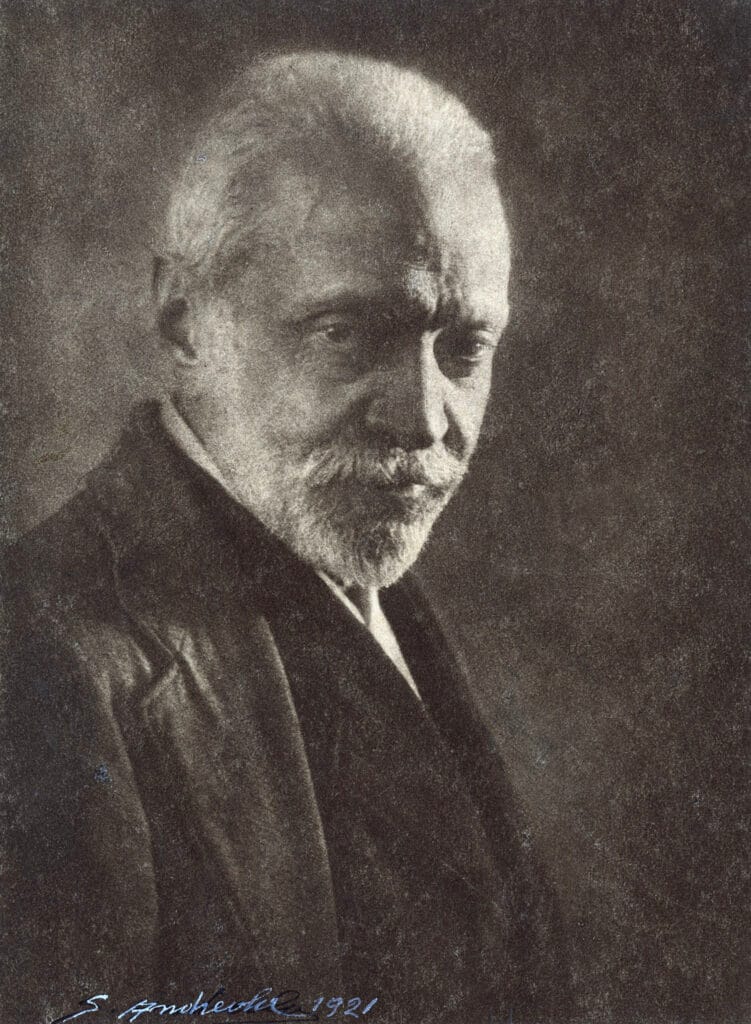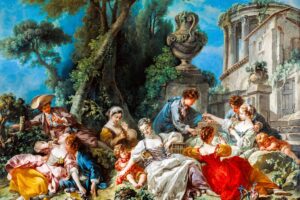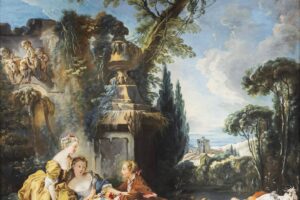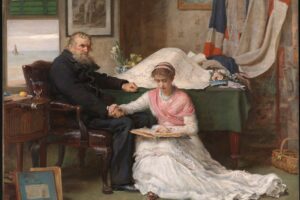Gaetano Bellei, 1857–1922 – Genre Painting and the Joys of Ordinary Life
Painted during the late 19th to early 20th century, The Joker by Italian artist Gaetano Bellei captures a warm, familiar kind of mischief. Bellei was part of a tradition of genre painters who focused not on myth or heroism, but on the lives of ordinary people—celebrating their humor, habits, and humanity. In this work, painted with remarkable realism and charm, we witness not a formal portrait or a grand narrative, but a moment of laughter between two elderly souls.
The Scene Before Us
An older man and woman sit at a table, remnants of a simple meal between them. The man gestures widely, his face lit up with delight, as if caught mid-punchline. Across from him, the woman hides her laughter behind her arm, flushed and delighted. Her headscarf and patterned blouse contrast with his rough jacket and red scarf. A half-empty bottle and two glasses of red wine hint at a shared story told over drink. There is no stage here, no spotlight—just the honest joy of two people who have known each other a long time.
The Deeper Meaning
At first glance, this may seem like mere comedy. But behind the humor is tenderness: a lifetime of shared meals, inside jokes, and resilient affection. Bellei’s technical skill allows each wrinkle, each fold of fabric, to feel alive and textured. Yet the true artistry lies in capturing an emotion that is fleeting—the precise moment of joy, untouched by pretense. These are not actors. They are us. Aging bodies, but youthful hearts. The painting reminds us that laughter does not retire with age; it grows deeper, richer, more precious.
A Moment Caught in Time
What makes this moment so vivid is its familiarity. We’ve seen this at family dinners, in village cafés, in our grandparents’ kitchens. It’s a universal scene—one that needs no translation. The white tablecloth, stained and crumpled, makes no attempt at elegance. The dishes have been used. The wine has been poured. What remains is connection. Bellei’s gift lies in making the ordinary beautiful, the everyday eternal. In this shared burst of laughter, the years vanish. They are not old. They are simply alive.
About Artist

Gaetano Bellei (born January 22, 1857, Modena, Italy – died March 20, 1922, Modena) was an Italian painter best known for his genre scenes, portraits, and religious works. He completed his artistic training at the Academy of Fine Arts in Modena under Adeodato Malatesta and further honed his skills at Rome’s Accademia di San Luca, the French Academy, and the Spanish Academy. Bellei exhibited widely in Italian cities like Turin, Milan, and Rome, as well as internationally in London at the Royal Academy in 1882. He taught at the Academy of Modena from 1893 until his late years.
Artist Style and Movement
Bellei worked primarily within the genre painting tradition, focusing on everyday scenes of rural life and intimate family moments, often featuring elderly people and children. His style blends excellent technical skill with a narrative sensibility that captures human emotions and interactions vividly and tenderly. Though rooted in academic tradition, some of his works showed influence from realism and symbolist tendencies, and he experimented occasionally with Art Nouveau and divisionism techniques. His paintings balance naturalistic detail with a warm, sometimes sentimental portrayal of Italian peasant life.
Artwork Profile / Notable Works
- The Cherries: A classic genre scene depicting a simple, joyful moment centered around sharing or enjoying cherries, embodying Bellei’s gift for capturing warm human interactions.
- The Happy Kitten (“Il micino fortunato”): Exhibited in 1885, this painting brought Bellei commercial success by illustrating a playful, heartwarming scene with a kitten that he reproduced in several variations.
- Resfa: A symbolist-inspired work with darker tones that initially caused controversy but later earned recognition as a significant contribution to modern art in Modena.
- The Port of Livorno: Demonstrates Bellei’s engagement with pointillist and divisionist brush techniques, capturing lively scenes with vibrant details.
- Religious paintings such as the altarpiece of the Redeemer for the parish of Zocca and the Blessed Cottolengo for the Rangoni chapel in Bomporto show his versatility beyond genre painting.
Gaetano Bellei remains an important figure in late 19th and early 20th-century Italian art, renowned for his ability to depict intimate scenes of human emotion with refined technical skill. His genre paintings continue to be appreciated for their narrative warmth and realism, providing a window into everyday Italian rural life and the emotional bonds within families.



